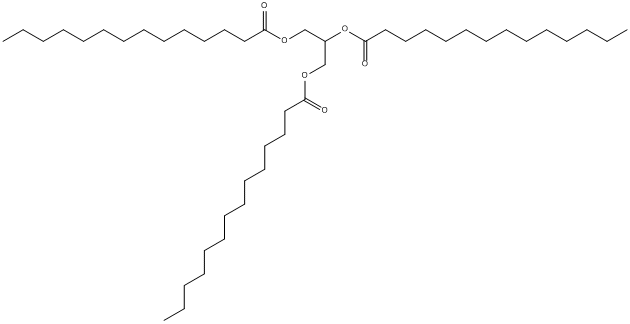Trimyristin
General
Type : Acyl-Glycerol || Triacylglycerol || Fatty acid ester || Water-insoluble medium and long chain ester || Tetradecanoate
Chemical_Nomenclature : 2,3-di(tetradecanoyloxy)propyl tetradecanoate
Canonical SMILES : CCCCCCCCCCCCCC(=O)OCC(COC(=O)CCCCCCCCCCCCC)OC(=O)CCCCCCCCCCCCC
InChI : InChI=1S\/C45H86O6\/c1-4-7-10-13-16-19-22-25-28-31-34-37-43(46)49-40-42(51-45(48)39-36-33-30-27-24-21-18-15-12-9-6-3)41-50-44(47)38-35-32-29-26-23-20-17-14-11-8-5-2\/h42H,4-41H2,1-3H3
InChIKey : DUXYWXYOBMKGIN-UHFFFAOYSA-N
Other name(s) : Glycerol trimyristate, Glyceryl trimyristate, Myristin, Glyceryl tritetradecanoate, CHEBI:77391, TG(42:0), ZINC85591205, C14-triglyceride, TG(14:0\/14:0\/14:0)

Target
Families : Acidic_Lipase, Lipase_2, ABHD6-Lip, Bacterial_lip_FamI.6
References (3)
| Title : Characterization of a novel lipase from Bacillus licheniformis NCU CS-5 for applications in detergent industry and biodegradation of 2,4-D butyl ester - Zhao_2021_Int.J.Biol.Macromol__ |
| Author(s) : Zhao J , Liu S , Gao Y , Ma M , Yan X , Cheng D , Wan D , Zeng Z , Yu P , Gong D |
| Ref : Int J Biol Macromol , : , 2021 |
| Abstract : Zhao_2021_Int.J.Biol.Macromol__ |
| ESTHER : Zhao_2021_Int.J.Biol.Macromol__ |
| PubMedSearch : Zhao_2021_Int.J.Biol.Macromol__ |
| PubMedID: 33548313 |
| Gene_locus related to this paper: bacld-q65hr4 |
| Title : Cloning, expression, and characterization of a cold-adapted lipase gene from an antarctic deep-sea psychrotrophic bacterium, Psychrobacter sp 7195 - Zhang_2007_J.Microbiol.Biotechnol_17_604 |
| Author(s) : Zhang J , Lin S , Zeng R |
| Ref : J Microbiol Biotechnol , 17 :604 , 2007 |
| Abstract : Zhang_2007_J.Microbiol.Biotechnol_17_604 |
| ESTHER : Zhang_2007_J.Microbiol.Biotechnol_17_604 |
| PubMedSearch : Zhang_2007_J.Microbiol.Biotechnol_17_604 |
| PubMedID: 18051271 |
| Gene_locus related to this paper: 9gamm-q2ktb4 |
| Title : Staphylococcus haemolyticus lipase: biochemical properties, substrate specificity and gene cloning - Oh_1999_FEMS.Microbiol.Lett_179_385 |
| Author(s) : Oh B , Kim H , Lee J , Kang S , Oh T |
| Ref : FEMS Microbiology Letters , 179 :385 , 1999 |
| Abstract : Oh_1999_FEMS.Microbiol.Lett_179_385 |
| ESTHER : Oh_1999_FEMS.Microbiol.Lett_179_385 |
| PubMedSearch : Oh_1999_FEMS.Microbiol.Lett_179_385 |
| PubMedID: 10518741 |
| Gene_locus related to this paper: staha-Q9RGZ6 |